Abstract
The Jiapigou mining district (>180 t Au) is an important gold district in China. For a long time, the ore genesis of the gold deposits in the Jiapigou district has been a subject of controversy and differing opinions, which has severely hindered metallogenic theories and mineral exploration. Here we present a comprehensive investigation including geology, fluid inclusions (FIs), and H–O–S isotopic data for the Naizhigou deposit in the Jiapigou district to elucidate the sources of orefluids and metals, as well as the metallogenic mechanism. The results show the following: (1) The Naizhigou deposit is characterized by quartz vein-type ores and is hosted in the Middle Jurassic granitic pluton. Native gold and sulfides were mainly deposited in the second stage (quartz–polymetallic sulfides) compared with the first (quartz–pyrite–molybdenite) and third (quartz–calcite) stages. (2) The FI studies indicated that the orefluids evolved from the early–main-stage CO2–H2O–NaCl system to the late-stage H2O–NaCl system and have homogenization temperatures of 289–363, 210–282, and 124–276 °C and salinities of 4.1–20.9, 5.8–16.4, and 6.1–12.7 wt% NaCl equivalent, respectively. Fluid boiling and fluid mixing collectively controlled the precipitation of gold and ore-forming elements. (3) The δD values of the FIs hosted in quartz from the three stags range from −81 to −75 ‰, from −99 to −86 ‰, and from −110 to −101 ‰, while δ18Owater values of these FIs range from 5.3 to 5.9 ‰, from 1.1 to 5.2 ‰, and from −2.1 to −0.7 ‰, respectively. Pyrite samples from the three stages in the Naizhigou deposit have δ34S values of 2.1 to 2.5 ‰, 3.1 to 4.3 ‰, and 3.8 to 3.9 ‰, respectively. The stable isotopes indicate that the orefluids and metals mainly originated from magma. A comparative study of regional observations reveals that the Naizhigou deposit is a magmatic-related mesothermal gold deposit, rather than a metamorphism-related orogenic gold deposit. The estimated ore-forming depths are 4.0–20.7 km, with exhumation depths of 4.1–5.5 km, which indicated that the deposit has been well preserved. Regionally, the new exploration strategies should place greater emphasis on work concerning ore-related plutons, ore-controlling faults, and hydrothermal alteration.
1. Introduction
The North China Craton (NCC), recognized as one of the oldest cratons worldwide (Figure 1A) [1], hosts abundant gold deposits. These gold deposits are district in the interior and margins of the NCC (Figure 1B), including the Jiaodong, Xiaoqinling, Chifeng–Chaoyang, Jibei–Jidong, Taihang Mountain, and Jiapigou districts (>6000 t Au) [2,3,4,5,6]. These gold deposits are generally featured by quartz vein-type ores, with secondary disseminated-type ores. They primarily formed at 175–164 Ma and 130–115 Ma [2,4,7,8]. Several sources for the orefluids, including the metamorphism of Precambrian crustal rocks or subducted Paleo-Pacific slab, magmatic exsolution, or enriched subcontinental lithospheric mantle, have been proposed and debated for decades ([3,4,8,9,10] and references therein). These controversies pose a challenge to develop the model for this type of gold deposit.
The Jiapigou district (>180 t Au), located in the NE margin of the NCC, hosts examples of quartz vein-type ores (i.e., the Jiapigou, Banmiaozi and Liupiye deposits), as well as disseminated- (i.e., the Songjianghe deposit) and breccia-type ores (i.e., the Toudaoliuhe deposit) [11]. Previous studies revealed that these gold deposits are mesothermal, formed predominantly in Middle Jurassic (178–170 Ma), and were genetically associated with synchronic intrusions [4,5,11,12,13]. However, some scholars have suggested that the gold mineralization in this district should be categorized as metamorphism-related orogenic gold deposits, based on regional metamorphism–deformation, metamorphic orefluids, multiple episodes of mineralization, and Neoarchean ore-hosting rocks ([14,15,16] and references therein). These controversies and/or distinct viewpoints have severely constrained our understanding of gold mineralization and mineral exploration.
Our recent research has found that the Naizhigou deposit is unique in that it occurs within the Middle Jurassic granite, exhibits similar characteristics and timing of mineralization to those of gold deposits in this district [17], and provides an opportunity to systematically decipher gold mineralization and ore genesis. Therefore, we present a study of geology, petrography, fluid inclusions (FIs), and stable isotopic data in the Naizhigou deposit to elucidate the sources of orefluids and metals, as well as the metallogenic mechanism. This finding, in conjunction with regional observations, can provide valuable information for exploration strategies.
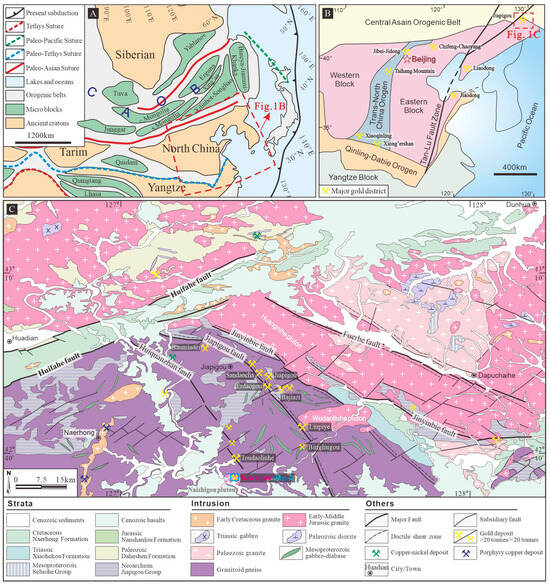
Figure 1.
(A) Tectonic map of the Eurasian continent [18], (B) tectonic map of the North China Craton ([19]), and (C) regional geological map of the Jiapigou district. Abbreviations: CAOB—Central Asian Orogenic Belt.
2. Regional Geology
The Naizhigou deposit is located in the southern part of the Jiapigou district, which hosts a variety of gold deposits (i.e., Jiapigou, Erdaogou, and Toudaoliuhe), as well as magmatic sulfide and porphyry deposits (Figure 1C) [4]. This district has experienced the formation of cratonic nuclei and cratonization during the Archean [20,21], the evolution of the Paleo-Asian Ocean during the Phanerozoic, and multiple episodes of subduction of the Paleo-Pacific Plate since the Late Triassic [4,22]. The strata in the Jiapigou district are mainly composed of the supracrustal rocks of the Neoarchean Jiapigou Group and various volcanic–sedimentary rocks of the Paleozoic to Mesozoic era, which have been well described (Figure 1C; i.e., [11,13,20,21] and references therein).
Widespread intrusions are widespread in the Jiapigou district (Figure 1C) and are mainly formed in five episodes: 2683–2462 Ma, 323–252 Ma, 247–208 Ma, 198–162 Ma, and 132–104 Ma ([4,11] and references therein). Among these, the 2683–2462 Ma granitoids are the predominant ore-hosting rocks and consist of granitoid gneisses and K-rich granites [11,20], which have undergone greenschist–amphibolite facies metamorphism [20]. The 198–162 Ma granitoids are recognized as regional plutons (Figure 1C; i.e., the Wudaoliuhe pluton), while synchronic mafic–felsic dikes (i.e., gabbro) occur as veins within multiple faults, especially NE- and NW-trending faults (Figure 1C and Figure 2) [13]. Recent detailed studies have demonstrated that these intrusions have a genetic relationship with the giant gold mineralization in the Jiapigou district and were formed in an extensional setting during the subduction process of the Paleo-Pacific Plate [11,13,23].
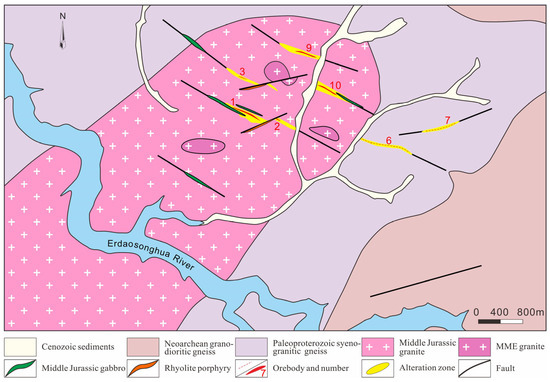
Figure 2.
Geological map of the Naizhigou gold deposit (modified after [24]).
The NW-trending faults, such as the Jiapigou and Huiquanzhan Faults, are distributed approximately in parallel and have predominant control on the gold deposits in this district, especially the Jiapigou Fault, which controls the distribution of more than 12 deposits (Figure 1C). More importantly, their subsidiary faults (i.e., NW-, NNW-, and NE-trending) largely govern the specific occurrence of all orebodies at the mine scale [4,5,11,12,13].
3. Ore Deposit Geology
The Naizhigou gold deposit (1.3 t Au and 11.7 t Ag), located in the southeastern part of the Huiquanzhan Fault, was discovered by Team 608 of the Jilin Nonferrous Geological Bureau in 1996 [24]. It is featured by quartz vein-type ores with minor disseminated-type ores. Orebodies at Naizhigou are mainly hosted in the Middle Jurassic Naizhigou pluton, with minor orebodies in the Paleoproterozoic syenogranitic gneiss (Figure 2). The Naizhigou pluton (ca. 177 Ma) [17] comprises granite and mafic microgranular enclave-bearing (MME) granite and has been crosscut by the gabbro and rhyolite porphyry (Figure 2). Moreover, the MME granite contains various alterations (i.e., quartz, K-feldspar, and epidote; Figure 3A,B), disseminated sulfide (i.e., pyrite and molybdenite; Figure 3A,B), and irregular MMEs (Figure 3B). The NW-trending faults are main ore-controlling faults, as they control the distribution of most orebodies (i.e., No. 1–3 and 9–10 orebodies) and syn-ore gabbro dikes, whereas the NE-trending faults generally crosscut the No. 1 and 3 orebodies and host the rhyolite porphyry and No. 6–7 orebodies (Figure 2 and Figure 3C).
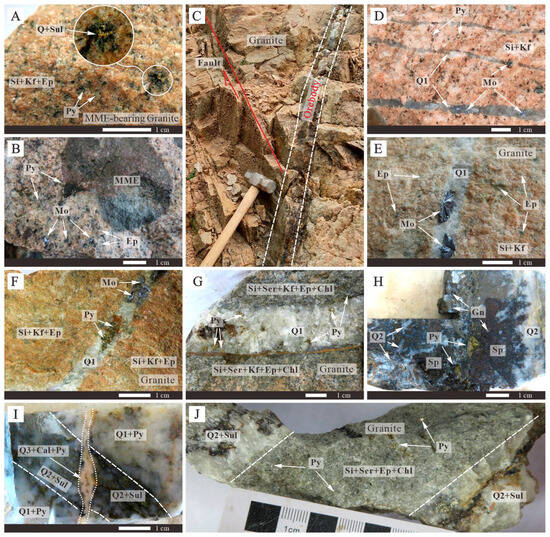
Figure 3.
Representative photographs of the major geological units, orebody, ores, minerals, and alteration of the Naizhigou gold deposit. (A) MME granite contains various alterations and sulfide aggregates. (B) The MME contains various mafic microgranular enclaves and disseminated molybdenite and pyrite. (C) Near-vertical orebody. (D) Three parallel early-stage quartz veins. (E,F) The early-stage molybdenite–pyrite-bearing quartz veins and proximal hydrothermal alteration. (G) Early-stage pyrite-bearing quartz veins and massive hydrothermal alteration. (H) Main-stage sulfide quartz vein. (I) Early- and main-stage minerals crosscut by a quartz–calcite vein. (J) The monzogranite between the two parallel main-stage sulfide quartz veins contains various hydrothermal alterations, producing pyrite, quartz, sericite, chlorite, and epidote. Abbreviations: Chl—chlorite; Ep—epidote; Kf—K-feldspar; MME—mafic microgranular enclave; Mo—molybdenite; Py—pyrite; Q1—early-stage quartz; Q2—main-stage quartz; Q3—late-stage quartz; Ser—sericite; Si—silicification; and Sul—sulfide.
Eighteen orebodies, including orebodies No. 1, 2, 3, 9, and 10, were controlled by the NW-trending faults. The typical No. 1 orebody has a length of more than 480 m and a depth of 340 m, with a thickness of 0.5–2.0 m, and dips at 70–75° SW, with an average grade of 8.92 g/t for Au and 328.86 g/t for Ag (Figure 3C) [24,25]. No. 3 orebody has a length of more than 25 m and a depth of 160 m, with a thickness of 0.65 m, and dips at 60° SW, with an average grade of 4.67 g/t for Au and 18.0 g/t for Ag [25].
Ores at Naizhigou have veinlet, vein, and massive structures (Figure 3D–J). Hydrothermal alterations are widely developed around the orebodies and ore-controlled faults. The alteration zone centered on the ore vein transitions from a narrow proximal zone of quartz–sericite–pyrite outward to a wide outer zone of K-feldspar–biotite (Figure 2 and Figure 3D–H). Carbonatization coexists with epidote–chlorite overprinting other earlier alterations (Figure 3F–I).
Three ore stages have been recognized at Naizhigou based on mineral assemblages and crosscutting relationships. They are quartz–pyrite–molybdenite (early-ore stage), quartz–polymetallic sulfides (main-ore stage), and quartz–calcite (late-ore stage) (Figure 4 and Figure 5). The early-ore stage is featured by molybdenite- and pyrite-bearing quartz veins and/or veinlets (Figure 3D–G and Figure 4A–C), which contains abundant euhedral–subhedral quartz (Q1) and a small amount of pyrite (Py1; cubes or aggregates) and molybdenite. The main-ore stage is represented by quartz–polymetallic sulfide veins and contains subhedral quartz (Q2), pyrite (Py2; subhedral cubes or anhedral grains), molybdenite, galena, sphalerite, chalcopyrite (Ccp), and native gold (Figure 4C–H). Spaces between the Py2 grains were filled by molybdenite (Figure 4F). Native gold occurs as irregular grains in interstitial spaces and coexists with Q2, Py2, Ccp, and galena (Figure 4F–H). The late-ore stage contains quartz–calcite veins, which cut into the earlier ore veins (Figure 3I and Figure 4I), and mainly contains subhedral quartz (Q3) and calcite, with minor amounts of pyrite (Py3), chlorite, and epidote.
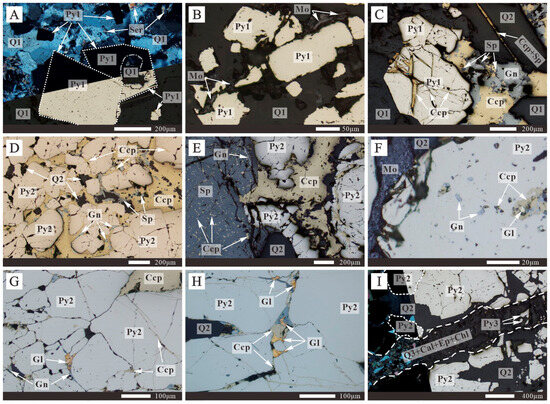
Figure 4.
Representative photographs of the ore texture, mineral assemblage, and hydrothermal alteration of the Naizhigou deposit. (A) Euhedral pyrite coexists with sericite and quartz in the early stage. (B) Spaces between the pyrite grains were filled by early-stage quartz and molybdenite. (C) Early-stage pyrite was metasomatized by main-stage chalcopyrite, sphalerite, and galena. (D) Spaces between the main-stage pyrite grains were filled by chalcopyrite, sphalerite, and galena. (E) Main-stage chalcopyrite occurred as exsolution in sphalerite. (F) Main-stage molybdenite coexists with pyrite, chalcopyrite, and native gold. (G,H) The occurrence of native gold. (I) Main-stage minerals were crosscut by a late-stage quartz–calcite vein. Abbreviations: Gl—native gold; Cal—calcite; Ccp—chalcopyrite; Gn—galena; Py1—early-stage pyrite; Py2—main-stage pyrite; Py3—late-stage pyrite; and Sp—sphalerite. Others are the same as those in Figure 3.
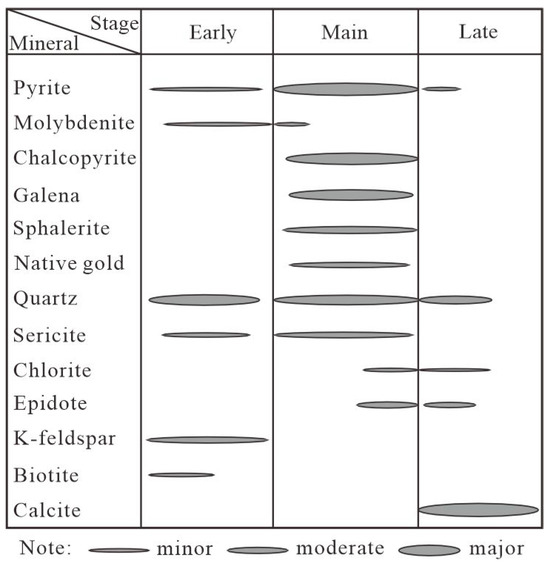
Figure 5.
Paragenetic sequences of the Naizhigou deposit. The ellipse represents the duration and intensity of mineralization.
4. Sample Preparation and Analytical Methods
4.1. Fluid Inclusion Analyses
Samples were collected from the surface of the No. 1 orebody in the Naizhigou deposit. Thirty-six representative samples were selected for microthermometry measurement and Laser Raman Spectroscopy analyses. The microthermometry measurement was conducted using a THMSG 600 heating–freezing stage (Linkam Scientific Instruments, Lincoln, UK) combined with a Carl Zeiss microscope (Carl Zeiss AG, Baden-Württemberg, Germany) at the FI Laboratory, Institute of Geology and Geophysics, Chinese Academy of Sciences (IGGCAS). The accuracy of the temperature measurement is reproducible within ± 0.2 °C for the freezing process and ±2 °C for the heating process. The salinities of the H2O–NaCl- and CO2-bearing inclusions were calculated using the equations of [26,27], respectively. The Flincor software (ver. 1.0) was used to calculate the densities and pressures of FIs according to the microthermometry data [28]. FI compositions were identified using a LabRam HR800 laser Raman probe (HORIBA JOBIN YVON, Paris, France) at the IGGCAS. The spectrum was measured from 100 to 4000 cm−1, and the resolution was ±2 °C during the measurement. For details on the methods and instrumental settings used during the above analyses, see [11,29].
4.2. Stable Isotopes
Ten quartz and ten pyrite samples from three ore stages from the Naizhigou deposit were subjected to hydrogen–oxygen (H–O) isotope and sulfur (S) isotope analyses, respectively. Quartz and pyrite grains were crushed to 40–80 mesh and then handpicked under a binocular microscope to achieve >99% purity [5]. The pyrite grains were further crushed to less than 200 mesh using an agate mill. The H–O isotope analyses were performed on a Finnigan MAT251 mass spectrometer at the Ministry of Natural Resources Key Laboratory of Metallogeny and Mineral Assessment, Institute of Mineral Resources, Chinese Academy of Geological Sciences. The O isotopic compositions of quartz and H isotopic compositions of FIs hosted in the quartz were analyzed using the BrF5 and Zn reduction methods, respectively [5]. The analytical precisions are ± 0.2 ‰ for δ18O and ± 2 ‰ for δD, respectively. The O isotope ratios of water in equilibrium with the quartz were calculated by using the equation of 1000 lnαquartz-H2O = 3.38 × 10−6 T−2 − 3.40 [28]. The “T” is the peak homogenization temperature of the corresponding FIs. The pyrite grains were mixed with cuprous oxide to produce SO2 by reaction at 980 °C [9]. The S isotope of SO2 was measured using a MAT-251 mass spectrometer at the analytical laboratory of the Beijing Research Institute of Uranium Geology. The analytical precision is better than ±0.2 ‰. For details on the methods and instrumental settings used during H–O–S isotope analyses, see [5,11].
5. Results
5.1. Fluid Inclusions
A range of three types of FIs was identified in quartz grains of three ore stages in the Naizhigou deposit. Primary FIs occur as isolated entities in intragranular quartz (Figure 6A,B), whereas pseudosecondary inclusions are mainly distributed along the internal fractures of quartz crystals but do not cut through the boundaries of the quartz grains, based on the methods reported by Lu et al. (2004) [30]. Secondary FIs generally occur along the trails (Figure 6A,B) and traverse the mineral grain boundaries (Figure 6B), which were excluded from this study. A total of 117 microthermometry measurements were acquired on FIs from 36 samples, and the results are summarized in Table 1 and Figure 6C–I and Figure 7.
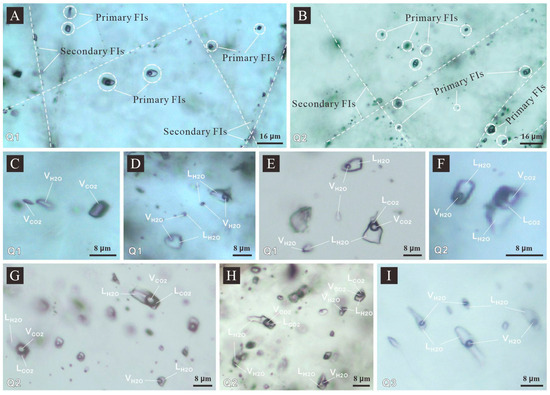
Figure 6.
Petrographic characteristics of FIs hosted in quartz grains of different stages from the Naizhigou deposit. (A,B) Primary and secondary FIs in early- and main-stage quartz; (C) PC-type FIs coexist with W-type FIs in early-stage quartz; (D) W-type FIs hosted in early-stage quartz; (E) C-type FIs coexist with W-type FIs in early-stage quartz; (F–H) C-type FIs coexist with W-type FIs in main-stage quartz; and (I) W-type FIs hosted in late-stage quartz. Abbreviations: FIs—fluid inclusions; VCO2—vapor CO2; LCO2—liquid CO2; VH2O—vapor H2O; and LH2O—liquid H2O. Others are the same as those in Figure 3.

Table 1.
Microthermometry data for FIs hosted in the quartz from different stages in the Naizhigou deposit.
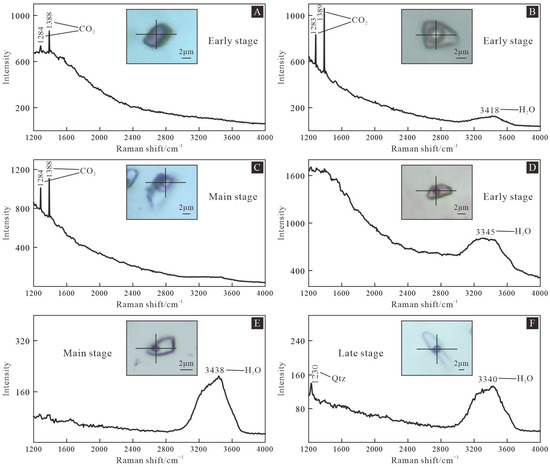
Figure 7.
Representative laser Raman spectra of FIs of different stages from the Naizhigou deposit. Spectrum for PC-type FIs (A), vapor phase of the C-type FIs (B), and vapor phase of the W-type FIs (D) hosted in early-stage quartz. Vapor phase of the C-type FIs (C), vapor phase of the W-type FIs (E), and vapor phase of the W-type FIs (F) hosted in late-stage quartz. Abbreviations: Qtz—quartz.
Three FI types were identified based on their compositions and phase transition; they are PC- (pure CO2), C- (CO2–H2O–NaCl), and W-type (H2O–NaCl) FIs [4,30]. Representative FI components of the FIs are shown in Figure 7. The vapor phase contents for PC- and C-type FIs from the early- to main-ore stages are mainly CO2 with minor amounts of H2O (Figure 7A,B,D). H2O is the main component for W-type FIs from the three stages (Figure 7C–F). The orefluids gradually evolved from a CO2–H2O–NaCl system in the early-ore stage to a H2O–NaCl system in the late-ore stage (Figure 7).
The PC-type FIs consist of pure carbonic fluid, including two-phase CO2 (LCO2 + VCO2) and mono-phase CO2 (LCO2 or VCO2), with sizes ranging from 6 to 13 µm. The PC-type FIs account for 1~4% and 1~6% of the total FIs in early- and main-stage quartz grains, respectively (Figure 6C and Figure 7A). The C-type FIs have irregular shapes (7–16 µm in size), commonly coexist with the W- and PC-type FIs (Figure 6 and Figure 7), and account for ~60% and ~35% of the total FIs in early- and main-stage quartz grains, respectively (Figure 6E–H and Figure 7A). The W-type FIs have irregular shapes (3 to 16 µm in size) and account for ~35%, ~60%, and 100% of the total FIs in early-, main-, and late-stage quartz grains, respectively (Figure 6I and Figure 7F).
Fluid inclusions in early-stage quartz grains: The C-type FIs have clathrate melting temperatures of 5.1–7.9 °C with calculated salinities of 4.1–8.8 wt% NaCl equivalent (Table 1; Figure 8A), CO2 phase homogenization temperatures (Th,CO2) of 21.2–31.0 °C, and total homogenization temperatures (Th,tot) of 295–363 °C (Figure 8B). The W-type FIs have final ice melting temperatures (Tm,ice) of −17.6 to −10.9 °C with calculated salinities of 14.9–20.9 wt% NaCl equivalent (Figure 8A) and Th,tot of 289–323 °C (Figure 8B). The PC-type FIs have first melting temperatures (Tm,CO2) of −57.3 to −56.7 °C and Th,CO2 of 24.5–30.7 °C, with calculated CO2 densities of 0.54–0.79 g/cm3 (Table 1).
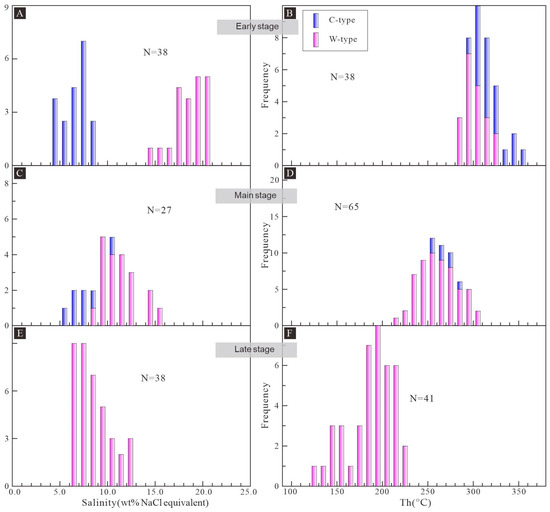
Figure 8.
Histograms of salinity (A,C,E) and total homogenization temperature (Th) (B,D,F) for C- and W-type FIs in different stages from the Naizhigou deposit.
Fluid inclusions in main-stage quartz grains: The C-type FIs have clathrate melting temperatures of 4.0–6.9 °C with calculated salinities of 5.8–10.5 wt% NaCl equivalent (Table 1; Figure 8C), Th,CO2 of 29.5–31.2 °C, and Th,tot of 260–282 °C (Figure 8D). The W-type FIs have Tm,ice of –12.4 to –5.5 °C with calculated salinities of 8.5–16.4 wt% NaCl equivalent (Figure 8C) and Th,tot of 210–274 °C (Figure 8D).
5.2. H–O–S Isotope Compositions
The results for H–O and S isotopes are listed in Table 2 and Table 3, respectively. The values of δ18Owater were calculated using the δ18Oquartz values and the peak Th,tot values of FIs in the corresponding three ore stages. In the Naizhigou deposit, the δD values of the FIs from the early, main, and late stages range from −81 to −75 ‰, from −99 to −86 ‰, and from −110 to −101 ‰, while the δ18O water values of these FIs range from 5.3 to 5.9 ‰, from 1.1 to 5.2 ‰, and from −2.1 to −0.7 ‰, respectively (Table 2 and Figure 9). Pyrite samples from early- to late-ore stages in the Naizhigou deposit have δ34S values of 2.1 to 2.5 ‰, 3.1 to 4.3 ‰, and 3.8 to 3.9 ‰, respectively (Table 3 and Figure 10).

Table 2.
H–O isotopic compositions of quartz-hosted FIs from the Naizhigou deposit.

Table 3.
Sulfur isotopic compositions of pyrites from the Naizhigou deposit.
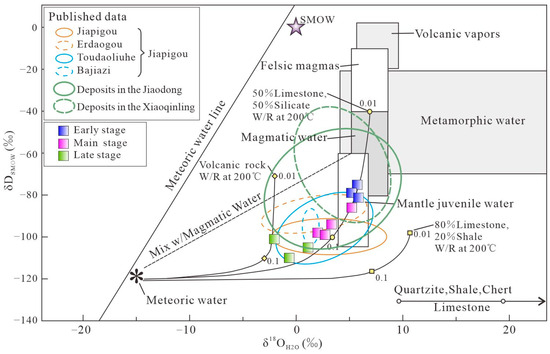
Figure 9.
δ18O–δD plots of ore fluids from the Naizhigou deposit [31,32]. The Mantle juvenile water field was revised according to [33]. The published data of the Jiapigou and Jiaodong districts are from [5,11,13,31,34,35,36,37,38]. Abbreviations: SMOW—Standard Mean Ocean Water.
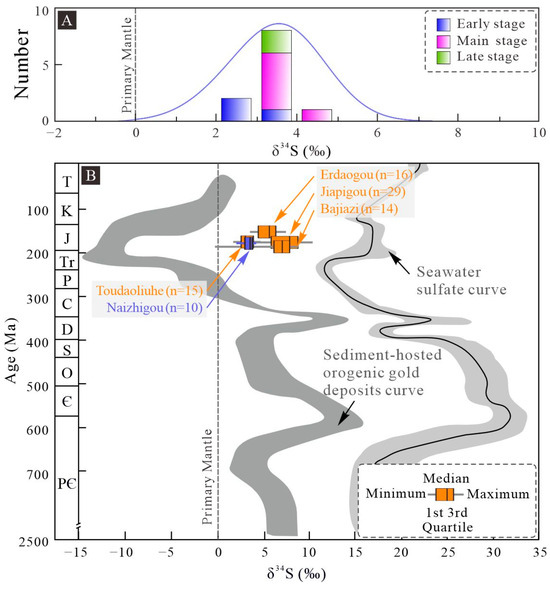
Figure 10.
Histogram of the S isotopic compositions of pyrite from the Naizhigou (A) deposit and box–whisker plots of δ34S values for the gold deposits in the Jiapigou district (B) showing the variations in the sulfur isotopic compositions of sulfides of global sediment-hosted orogenic gold deposits and marine sulfate curves through geologic time [39,40]. The published data sources of the gold deposits in the Jiapigou district are the same as those in Figure 9.
6. Discussion
6.1. Ore Genesis
For a long time, the ore genesis of gold deposits in the Jiapigou district has raised controversy and/or different opinions. Some scholars suggested that these deposits are of the metamorphic fluid-related orogenic type ([9,10,14,15,16] and references therein), while others propose that they are of the magmatic-related mesothermal type [4,11,13,31]. Research on their genesis is meaningful for understanding the giant gold mineralization in this district.
Geological features: The timing of emplacement of the ore-related intrusions (i.e., granitoids and basic dikes) and gold mineralization in the Jiapigou district was constrained to 177–173 Ma and 178–170 Ma, respectively ([4,13] and references therein). Although gold deposits in this district are commonly hosted within various Neoarchean units, e.g., the granitoid gneisses and/or supracrustal rocks of the Jiapigou Group [13,31], the significant time gap between the Neoarchean metamorphism and Middle Jurassic gold mineralization roughly rules out a metamorphic origin for this gold mineralization. The Naizhigou deposit is hosted in the Middle Jurassic granite (ca. 177 Ma) and was formed at 177 ± 1 Ma [17], which is consistent with the mineralization period in the Jiapigou district. Sulfides at Naizhigou constitute a minor fraction of the total ores (≤15 vol.%), consisting mainly of pyrite, sphalerite, and galena (Figure 11A; i.e., the Jiapigou and Liupiye deposits) [13].
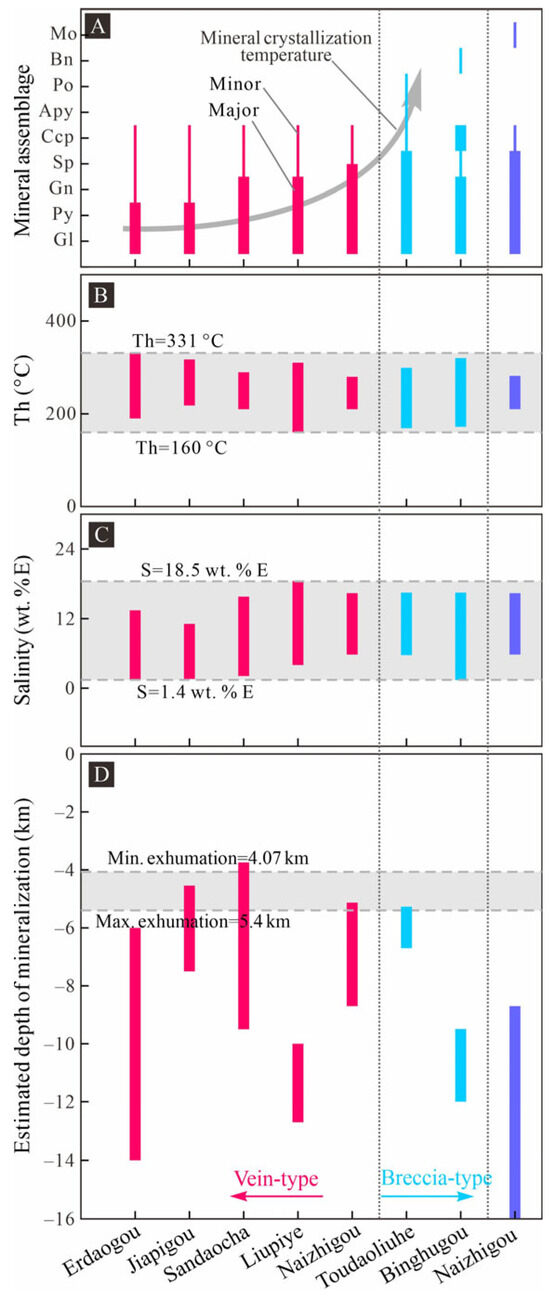
Figure 11.
Comparison of the mineral assemblage (A), homogenization temperature (B), salinity (C), and estimated depth of mineralization (D) for the deposits in the Jiapigou district. The published data of the gold deposits in the Jiapigou district are from [5,15] and references therein.
Constraints on the orefluid source: The early-stage orefluids have δD values of −81 to −75 ‰ and δ18Owater values of 5.3 to 5.9 ‰ (Table 2). These values are plotted in the field of magmatic and/or mantle water on the H–O isotopic diagram (Figure 9), indicating initial mantle- and/or magma-derived fluids, rather than a metamorphic fluid of the orogenic gold deposits [9,41], consistent with those of the deposits in the Jiapigou, Jiaodong [34], and Xiaoqinling [35,36] districts (Figure 9). Furthermore, the S isotopes of the Naizhigou deposit and other gold deposits in the Jiapigou district range from 2.12 to 4.28 ‰ and from 2.5 to 8.0 ‰ (Figure 10A), indicating that the ore materials originated from magma (0 ± 5 ‰) rather than a metamorphic origin (−20 to +20 ‰ [5]) of orogenic gold deposits (Figure 10B) [9,42]. The FI results and petrographic observations indicate that the initial orefluids of the Naizhigou deposit belonged to a H2O–CO2–NaCl system (Figure 6 and Figure 7) and are featured by moderate temperatures (289–366 °C) and various salinities of 4.1–20.9 wt% NaCl equivalent (Table 1 and Figure 8A, B). These features are similar to those of deposits in the Jiapigou district (Figure 6 and Figure 11B–D; i.e., the Erdaogou and Toudaoliuhe deposits) and the magmatic-related mesothermal gold deposits in the Xiaoqinling and Jiaodong districts (Figure 9; [3,19]).
Deposition mechanism: Plentiful W-type FIs with various vapor-to-liquid ratios coexist with C- and PC-type FIs in the early- to main-stage quartz, which is in accordance with boiling-related FIs in many Cu–Au hydrothermal systems [2]. Fluid boiling at Naizhigou is also supported by W- and PC-type FIs, which have similar Th,tot but distinct salinities (Table 1 and Figure 11). Fluid boiling changed the physicochemical conditions within the orefluid, promoting the precipitation of gold and sulfides. The decreasing features of temperatures and H–O isotopes indicate that fluid mixing occurred between orefluids and meteoric water in the late-ore stage (Table 2 and Figure 9 and Figure 11). In the main-ore stage, the presence of PC- and W-type FIs indicated that fluid boiling results in a broad range of fluid salinities, which disrupt the stability of complexes in the orefluids and the gold solubility in the ore-forming fluid, thereby promoting the precipitation of gold and sulfides [7,9,11]. These mechanisms collectively controlled the precipitation of gold and sulfides in the Naizhigou and other gold deposits in the Jiapigou district [5,13].
The above evidence strongly supports that the Naizhigou and coeval gold deposits in the Jiapigou district are magmatic-related mesothermal gold deposits (for more information on the concept of “mesothermal gold deposits”, please refer to the following references: [3,7,43,44,45]).
6.2. Ore-Forming Depth and Preservation
This study reveals that the orefluids of the main-ore stage from the Naizhigou deposit belong to the boiling-related CO2–H2O FIs (Figure 6, Figure 7 and Figure 11), and thus the Th,tot and estimated pressures of the main-stage FIs can represent the minimum temperature and pressure without the need for pressure correction [46]. Here, CO2 densities (0.54–0.63 g/cm3) and the Th,tot (260–282 °C) of the C-type FIs of the main stage were used for the calculation of the trapping pressure, based on the Flincor Program [47]. The calculated pressures for the main-stage orefluids of the Naizhigou deposit range from 207 to 238 MPa (Figure 12). Orebodies at Naizhigou are mainly hosted in the NW-trending faults; therefore the ore-forming depth is estimated to be 8.7–20.7 km for the Naizhigou deposit, using lithostatic and hydrostatic pressures (2.75 and 1.00 g/cm3, respectively; [9]), which are used to estimate the maximum and minimum values of the orefluids, respectively. The estimated ore-forming depth of the Naizhigou deposit is generally slightly deeper than that of other deposits in the Jiapigou district (a broad depth range but concentrated between 4 and 12 km; Figure 11D) [5] and is consistent with that of the gold deposits in the Jiaodong district in the eastern margin of the NCC [3]. These observations, combined with the post-ore exhumation depth of 4.1–5.5 km for the Jiapigou district [5,48], indicate that the Naizhigou and other deposits in this district have been well preserved.
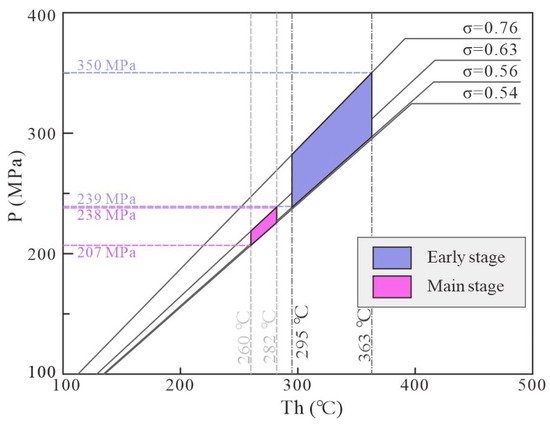
Figure 12.
The estimated trapping pressure–temperature conditions for the early and main stages in the Naizhigou deposit. The isochores were calculated based on the H2O–CO2–NaCl system using the Flincor software [28].
6.3. Implications for Regional Exploration Strategy
Abundant evidence regarding the geology from the regional scale to the deposit scale, ore-related magmatism, chronology, orefluids, and C–H–O–S–Pb–He–Ar isotopes obtained in the Jiapigou district by this and other recent studies have revealed that the gold deposits in this district belong to magmatic-related mesothermal gold deposits, rather than orogenic gold deposits, and are genetically related to the Jurassic intrusions [4,5,11,12,13,31]. This study, through research on the Jurassic granite-hosted Naizhigou deposit and comparisons with other gold deposits in this district, strongly supports the aforementioned conclusion. This implies that exploration strategies based on orogenic gold theories, such as those targeting ductile shear zones and granite–greenstone belts, will be entirely inapplicable to this district, and a new exploration strategy is required.
Regionally, Archean units, including granitoid gneisses and supracrustal rocks, are distributed in the southwestern part of the Jiapigou district, while Jurassic granite is found in the northeastern and northwestern parts (Figure 1C). Granite intruded from the base of the Archean units into their interior, with some plutons exposed, such as the Wudaoliuhe and Naizhigou plutons, indicating the presence of concealed granitic plutons beneath the Archean units (Figure 1C) [4]. Based on these two major units in the Jiapigou district, we propose the following exploration strategies.
Ore-related plutons: Most deposits in this district are located less than 6 km from syn-ore plutons (Figure 1C). For example, the Liupiye deposit is situated less than 2.5 km from the Wudaoliuhe pluton, and the Naizhigou deposit is even found within the Naizhigou pluton. An et al. (2018) [49] reported that several Au and/or Ag occurrences are found within the Wudaoliuhe pluton and at the margin of the Huangnihe pluton. These findings suggest that both the interiors and vicinities of the syn-ore plutons are favorable areas for gold mineralization.
Ore-controlling faults: The vast majority of gold deposits in the Jiapigou district are controlled by the Jiapigou and Huiquanzhan Faults and their associated subsidiary faults, both on a regional scale and on a mine scale (Figure 1C). For example, the subsidiary faults of the Jiapigou Fault control orebodies in the Jiapigou (NE-trending fault), Erdaogou (NW-trending fault), and Liupiye (NW-trending fault) deposits [5,13], while the NW- to NWW-trending subsidiary faults of the Huiquanzhan Fault control the occurrence of orebodies in the Laoling and Naizhigou deposits ([49]; this study). Notably, orebodies in breccia-type deposits are generally controlled by multiple fault sets trending in different directions. For instance, the orebodies at Toudaoliuhe are controlled by NW-, EW-, and NS-trending faults, whereas those at Binghugou are controlled by the NW-, NE-, and EW-trending faults [4]. Moreover, syn-ore mafic dikes (i.e., gabbro and diorite) generally accompany orebodies and are mainly controlled by ore-controlling faults at the mine scale. These pieces of evidence indicate that the systematic identification of these two faults and their subsidiary faults, especially those containing mafic dikes, is conducive to mineral exploration.
Hydrothermal alteration: Similar to typical magmatic–hydrothermal Cu-Au mineralization, hydrothermal alterations in the Jiapigou district are extensively developed around the ore bodies and along ore-controlling faults. These alterations, centered on the ore veins, grade outward from a narrow proximal zone of quartz–sericite–pyrite [12,13]. The identification and tracing of the alteration zones of quartz–sericite–pyrite constitute an extremely effective method for exploration in the Jiapigou district. Additionally, considering that the Archean units in the Jiapigou district have extensively undergone regional metamorphism and deformation, resulting in the formation of hydrothermal minerals such as K-feldspar, epidote, muscovite, and chlorite [20,21], the presence of a single type of alteration involving these hydrothermal minerals holds no significance for guiding mineral exploration.
In summary, exploration strategies in the Jiapigou district should focus on the Middle Jurassic granitic plutons associated with gold mineralization, as well as the identification and tracing of ore-controlling faults and alteration zones.
7. Conclusions
(1) The Naizhigou gold deposit is characterized by quartz vein-type ores and is hosted in the Middle Jurassic granitic pluton. Three ore stages were recognized at Naizhigou based on mineral assemblages and crosscutting relationships; they are quartz–pyrite–molybdenite, quartz–polymetallic sulfides, and quartz–calcite. Native gold and sulfides were mainly deposited in the second stage.
(2) Fluid inclusion studies indicated that the orefluids evolved from the early-stage CO2–H2O–NaCl system to the late-stage H2O–NaCl system. Fluid boiling and fluid mixing in the main-ore stage collectively controlled the precipitation of gold and sulfides at Naizhigou. The H–O–S isotopes suggest that the orefluids and metals of the Naizhigou deposit were predominantly of synchronous magma rather than metamorphic origin.
(3) A comparative study of geology, chronology, orefluids, and deposition mechanisms between the Naizhigou and other gold deposits in the Jiapigou district reveals that the Naizhigou and synchronic gold deposits in the Jiapigou district are magmatic-related mesothermal gold deposits, rather than orogenic gold deposits.
(4) The ore-forming depths are estimated to be 8.7–20.7 km for the Naizhigou deposit and 4–12 km for other deposits in the Jiapigou district and are significantly greater than the post-ore exhumation depths of 4.1–5.5 km, which indicated that the gold deposits in this district have been well preserved. Regionally, new exploration strategies should place greater emphasis on ore-related plutons, ore-controlling faults, and hydrothermal alterations.
Author Contributions
Conceptualization, J.H. and Z.L.; methodology, J.H. and C.Z.; software, X.Z. (Xinwen Zhang); validation, J.H. and S.W.; formal analysis, X.Z. (Xiaotian Zhang); investigation, J.H., J.S. and S.W.; resources, J.H.; data curation, J.H.; writing—original draft preparation, J.H.; writing—review and editing, Z.L., C.Z. and J.S.; visualization, X.Z. (Xiaotian Zhang); supervision, Z.L.; project administration, J.H.; funding acquisition, J.H. and X.Z. (Xinwen Zhang). All authors have read and agreed to the published version of the manuscript.
Funding
This research was financially supported by the National Natural Science Foundation of China (Grant No. 42202068, 42302103, 42072085 and 92162323), the China Postdoctoral Science Foundation (2023M743306), and the Chinese Geological Survey Programme (No. DD20221692).
Data Availability Statement
The authors confirm that the data supporting the findings of this study are available in the manuscript. The data in this study are unpublished and have not been submitted to any other journal for review.
Acknowledgments
We are very grateful to three anonymous reviewers for their criticism and constructive comments and suggestions, which are helpful for revising our manuscript and guiding our future research.
Conflicts of Interest
The authors declare no conflicts of interest.
References
- Zhao, G.C.; Cawood, P.A.; Li, S.Z.; Wilde, S.A.; Sun, M.; Zhang, J.; He, Y.H.; Yin, C.Q. Amalgamation of the North China Craton: Key issues and discussion. Precambrian Res. 2012, 222–223, 55–76. [Google Scholar] [CrossRef]
- Deng, J.; Wang, Q. Gold mineralization in China: Metallogenic provinces, deposit types and tectonic framework. Gondwana Res. 2016, 36, 219–274. [Google Scholar] [CrossRef]
- Deng, J.; Qiu, K.F.; Wang, Q.F.; Goldfarb, R.; Yang, L.Q.; Zi, J.W.; Geng, J.Z.; Ma, Y. In situ dating of hydrothermal monazite and implications for the geodynamic controls on ore formation in the Jiaodong gold province, eastern China. Econ. Geol. 2020, 115, 671–685. [Google Scholar] [CrossRef]
- Han, J.L.; Deng, J.; Zhang, Y.; Sun, J.G.; Wang, Q.F.; Zhang, Y.M.; Zhang, X.T.; Liu, Y.; Zhao, C.T.; Yang, F.; et al. Au mineralization-related magmatism in the giant Jiapigou mining district of Northeast China. Ore Geol. Rev. 2022, 141, 104638. [Google Scholar] [CrossRef]
- Han, J.L.; Sun, J.G.; Zhang, X.T.; Liu, Y.; Xu, Z.K.; Wang, S.; Xu, Z.T.; Li, X. Comparison of vein- and breccia-type Au-mineralization in the giant Jiapigou mining district of Northeast China. Ore Geol. Rev. 2022, 141, 105173. [Google Scholar] [CrossRef]
- Zhen, S.M.; Wang, Q.F.; Wang, D.Z.; Carranza, E.J.M.; Liu, J.J.; Pang, Z.S.; Cheng, Z.Z.; Xue, J.L.; Wang, J.; Zha, Z.J. Genesis of the Zhangquanzhuang gold deposit in the northern margin of North China Craton: Constraints from deposit geology and ore isotope geochemistry. Ore Geol. Rev. 2020, 122, 103511. [Google Scholar] [CrossRef]
- Yu, B.; Zeng, Q.D.; Frimmel, H.E.; Wang, Y.B.; Guo, W.K.; Sun, G.T.; Zhou, T.C.; Li, J.P. Genesis of the Wulong gold deposit, northeastern North China Craton: Constraints from fluid inclusions, H–O–S–Pb isotopes, and pyrite trace element concentrations. Ore Geol. Rev. 2018, 102, 313–337. [Google Scholar] [CrossRef]
- Wang, Q.F.; Groves, D.I.; Deng, J.; Li, H.J.; Yang, L.; Dong, C.Y. Evolution of the Miocene Ailaoshan orogenic gold deposits, southeastern Tibet, during a complex tectonic history of lithosphere-crust interaction. Miner. Depos. 2020, 55, 1085–1104. [Google Scholar] [CrossRef]
- Goldfarb, R.J.; Groves, D.I. Orogenic gold: Common or evolving fluid and metal sources through time. Lithos 2015, 233, 2–26. [Google Scholar] [CrossRef]
- Goldfarb, R.J.; Qiu, K.F. The Jiaodong gold deposits of the North China block—A possible Sulu terrane source. Aust. J. Earth Sci. 2025, 1–17. [Google Scholar] [CrossRef]
- Han, J.L.; Sun, J.G.; Liu, Y.; Zhang, X.T.; He, Y.P.; Yang, F.; Chu, X.L.; Wang, L.L.; Wang, S.; Zhang, X.W.; et al. Genesis and age of the Toudaoliuhe breccia-type gold deposit in the Jiapigou mining district of Jilin Province, China: Constraints from fluid inclusions, H–O–S–Pb isotopes, and sulfide Rb–Sr dating. Ore Geol. Rev. 2020, 188, 103356. [Google Scholar] [CrossRef]
- Deng, J.; Yuan, W.M.; Carranza, E.J.M.; Yang, L.Q.; Wang, C.M.; Yang, L.Y.; Hao, N.N. Geochronology and thermochronometry of the Jiapigou gold belt, northeastern China: New evidence for multiple episodes of mineralization. J. Asian Earth Sci. 2014, 89, 10–27. [Google Scholar] [CrossRef]
- Zhang, X.T.; Sun, J.G.; Han, J.L.; Feng, Y.Y. Genesis and mineralizing process of the Benqu mesothermal gold deposit in the Jiapigou ore cluster, NE China: Constraints from geology, geochronology, fluid inclusions, and whole-rock and isotope geochemistry. Ore Geol. Rev. 2021, 130, 103956. [Google Scholar] [CrossRef]
- Yang, L.Y.; Yang, L.Q.; Yuan, W.M.; Zhang, C.; Zhao, K.; Yu, H.J. Origin and evolution of ore fluid for orogenic gold traced by D-O isotopes: A case from the Jiapigou gold belt, China. Acta Petrol. Sin. 2013, 29, 4025–4035. [Google Scholar]
- Liu, S.F.; Wang, Q.F.; Groves, D.I.; Wang, Z.M.; Yang, L.; Wu, Z.L.; Yu, Z.Y.; Huang, P.F.; Deng, J. Adoption of a mineral system model in successful deep exploration at Erdaogou, China’s deepest gold mine, on the northeastern margin of the North China Craton. Ore Geol. Rev. 2021, 131, 104060. [Google Scholar] [CrossRef]
- Badhe, K.; Ni, P.; Wang, G.G.; Liu, Z.; Li, W.S.; Ding, J.Y.; Pan, J.Y. Fluid inclusion and pyrite geochemistry of the Jiapigou gold deposit, North China Craton: Implication for origin of orogenic gold deposit? Ore Geol. Rev. 2024, 174, 106281. [Google Scholar] [CrossRef]
- Han, J.L.; Lü, Z.C.; Liu, Y.P.; Zhang, X.T.; Sun, J.G.; Wang, S.; Zhang, X.W.; Wang, Q. Jurassic giant Au-mineralization in the Jiapigou district of NE China: Constrains from zircon U–Pb and molybdenite Re–Os dating of the Naizhigou deposit. Ore Geol. Rev. 2025; submitted for publication. [Google Scholar]
- Kröner, A.; Kovach, V.; Belousova, E.; Hegner, E.; Armstrong, R.; Dolgopolova, A.; Seltmann, R.; Alexeiev, D.V.; Hoffmann, J.E.; Wong, J.; et al. Reassessment of continental growth during the accretionary history of the Central Asian Orogenic Belt. Gondwana Res. 2014, 25, 103–125. [Google Scholar] [CrossRef]
- Xiong, S.F.; Jiang, S.Y.; Zhao, K.D.; Ma, Y.; Chen, Q.Z.; Jiang, M.R. Gold distribution and source of the J4 gold-bearing breccia pipe in the Qiyugou district, North China Craton: Constraints from ore mineralogy and in situ analysis of trace elements and S–Pb isotopes. Ore Geol. Rev. 2019, 105, 514–536. [Google Scholar] [CrossRef]
- Guo, B.R.; Liu, S.W.; Zhang, J.; Wang, W.; Fu, J.H.; Wang, M.J. Neoarchean Andean-type active continental margin in the northeastern North China Craton: Geochemical and geochronological evidence from metavolcanic rocks in the Jiapigou granite–greenstone belt, Southern Jilin Province. Precambrian Res. 2016, 285, 147–169. [Google Scholar] [CrossRef]
- Yu, R.D.; Sun, J.G.; Wang, S.; Han, J.L.; Liu, Y. Neoarchean–early Paleoproterozoic crustal evolution in the Jiapigou terrane in the northeastern part of the North China Craton: Geochemistry, zircon U–Pb dating and Hf isotope constraints from the potassic granitic complex. Precambrian Res. 2021, 364, 106341. [Google Scholar] [CrossRef]
- Sun, J.G.; Xing, S.W.; Zheng, Q.D. Geodynamic and Geochemistry of Nonferrous and Noble Metal Deposits, Northeastern China; Jilin University Press: Changchun, China, 2006; pp. 1–128. (In Chinese) [Google Scholar]
- Xu, W.L.; Pei, F.P.; Wang, F.; Meng, E.; Ji, W.Q.; Yang, D.B.; Wang, W. Spatial–temporal relationships of Mesozoic volcanic rocks in NE China: Constraints on tectonic overprinting and transformations between multiple tectonic regimes. J. Asian Earth Sci. 2013, 74, 167–193. [Google Scholar] [CrossRef]
- Yu, C.H.; Zang, X.Y.; Li, Y.X. Geological characteristics in Naizigou gold deposit in Huadian County, Jilin Province and their prospecting significance. Gold 2014, 35, 19–21, (In Chinese with English abstract). [Google Scholar]
- Fu, M. The geological characteristics and metallogenic regularity of gold deposits in Milk ditches in Huadian City, Jilin Province. Miner. Resour. 2018, 14, 125–127, (In Chinese with English abstract). [Google Scholar]
- Bodnar, R.J. Revised equation and table for determining the freezing point depression of H2O–NaCl solutions. Geochim. Cosmochim. Acta 1993, 57, 683–684. [Google Scholar] [CrossRef]
- Collins, P.L.F. Gas hydrates in CO2-bearing fluid inclusions and use freezing data for estimation of salinity. Econ. Geol. 1979, 74, 1435–1444. [Google Scholar] [CrossRef]
- Brown, P.E.; Lamb, W.M. P–V–T properties of fluids in the system H2O±CO2±NaCl: New graphic presentations and implications for fluid inclusion studies. Geochim. Cosmochim. Acta 1989, 53, 1209–1221. [Google Scholar] [CrossRef]
- Fan, H.R.; Zhai, M.G.; Xie, Y.H.; Yang, J.H. Mineralizing fluids associated with granite-hosted gold mineralization at the Sanshandao deposit, Jiaodong gold province, China. Miner. Depos. 2003, 38, 739–750. [Google Scholar] [CrossRef]
- Lu, H.Z.; Fan, H.R.; Ni, P.; Ou, G.X.; Shen, K.; Zhang, W.H. Fluid Inclusions; Science Press: Beijing, China, 2004; pp. 1–487. (In Chinese) [Google Scholar]
- Zeng, Q.D.; Wang, Z.C.; He, H.Y.; Wang, Y.B.; Zhang, S.; Liu, J.M. Multiple isotope composition (S, Pb, H, O, He, and Ar) and genetic implications for gold deposits in the Jiapigou gold belt, northeast China. Miner. Depos. 2014, 49, 145–164. [Google Scholar] [CrossRef]
- Taylor, H.P.J. Oxygen and hydrogen isotope relationships in hydrothermal mineral deposits. In Geochemistry of Hydrothermal Ore Deposits; Barnes, H.L., Ed.; John Wiley & Sons Inc.: New York, NY, USA, 1997; pp. 229–302. [Google Scholar]
- Craig, H.; Lupton, J.E. Lupton primordial neon, helium and hydrogen in oceanic basalts. Earth Planet. Sci. Lett. 1976, 31, 369–385. [Google Scholar] [CrossRef]
- Shen, B.F.; Li, J.J.; Mao, D.B.; Li, S.B.; Liu, Z.S.; Zhang, W.J.; An, C.T. Geology and Metallogenic Process of Jiapigou Gold Deposit in Jilin Province; Geological Publishing House: Beijing, China, 1998; pp. 1–172, (In Chinese with English abstract). [Google Scholar]
- Huang, Z.X. Tectonics–Fluids–Mineralization System of Jiapigou Gold Belt in the Jilin Province, China. Ph.D. Thesis, China University of Geosciences Beijing, Beijing, China, 2012; 255p. (In Chinese with English abstract). [Google Scholar]
- Deng, J.; Yang, L.Q.; Groves, D.I.; Zhang, L.; Qiu, K.F.; Wang, Q.F. An integrated mineral system model for the gold deposits of the giant Jiaodong province, eastern China. Earth Sci. Rev. 2020, 208, 103274. [Google Scholar] [CrossRef]
- Liu, J.C. Origins of the Ore-Forming Materials and Enrichment Mechanism in the Xiaoqinling Goldfield, Southern Margin of the North China Craton: A case study of the Fancha gold deposit. Ph.D. Thesis, China University of Geosciences Beijing, Beijing, China, 2020; pp. 1–255, (In Chinese with English abstract). [Google Scholar]
- Zhou, Z.J.; Chen, Y.J.; Jiang, S.Y.; Zhao, H.X.; Qin, Y.; Hu, C.J. Geology, geochemistry and ore genesis of the Wenyu gold deposit, Xiaoqinling gold field, Qinling Orogen, southern margin of North China Craton. Ore Geol. Rev. 2014, 59, 1–20. [Google Scholar] [CrossRef]
- Chang, Z.S.; Large, R.R.; Maslennikov, V. Sulfur isotopes in sediment-hosted orogenic gold deposits: Evidence for an early timing and a seawater sulfur source. Geology 2008, 36, 971–974. [Google Scholar] [CrossRef]
- Hoefs, J. Stable Isotope Geochemistry, 4th ed.; Springer: Berlin/Heidelberg, Germany, 1997; pp. 1–201. [Google Scholar]
- Groves, D.I.; Santosh, M. The giant Jiaodong gold province: The key to a unified model for orogenic gold deposits? Geosci. Front. 2016, 7, 409–417. [Google Scholar] [CrossRef]
- Groves, D.I.; Santosh, M. Craton and thick lithosphere margins: The sites of giant mineral deposits and mineral provinces. Gondwana Res. 2021, 100, 195–222. [Google Scholar] [CrossRef]
- Li, J.W.; Bi, S.J.; Selby, D.; Chen, L.; Vasconcelos, P.; Thiede, D.; Zhou, M.F.; Zhao, X.F.; Li, Z.K.; Qiu, H.N. Giant Mesozoic gold provinces related to the destruction of the North China craton. Earth Planet. Sci. Lett. 2012, 349–350, 26–37. [Google Scholar] [CrossRef]
- Yang, Q.; Ren, Y.S.; Hao, Y.J.; Wang, B.; Sun, Z.M.; Li, J.M. Ore fluid, geochronology and tectonic setting of mesothermal gold metallogeny in southeastern Jilin Province, Northeast China: A case study of the Shajingou gold deposit. Ore Geol. Rev. 2019, 109, 229–252. [Google Scholar] [CrossRef]
- Shang, Q.Q.; Ren, F.D.; Yang, Q.; Wang, B. In Situ Compositional and Sulfur Isotopic Analysis of Sphalerite from the Erdaodianzi Gold Deposit in Southern Jilin Province, Northeast China. Minerals 2025, 15, 57. [Google Scholar] [CrossRef]
- Simeone, R.; Simmons, S.F. Mineralogical and fluid inclusion studies of low-sulfidation epithermal veins at Osilo (Sardinia), Italy. Miner. Depos. 1999, 34, 705–717. [Google Scholar] [CrossRef]
- Brown, P.E. Flincor: A microcomputer program for the reduction and investigation of fluid inclusion data. Am. Mineral. 1989, 74, 1390–1393. [Google Scholar]
- Feng, Y.L.; Yuan, W.M.; Hao, N.N.; Duan, H.W.; Chen, X.N.; Cao, J.H. Denudation and conservation history of local district in Jiapigou gold deposit, Huadian county, Jilin Province: Evidence from apatite fission track thermochronology. Geol. Rev. 2015, 61, 109–120, (In Chinese with English abstract). [Google Scholar]
- An, J.H.; Sun, J.G.; Wang, S. Achievement Report of the Mineral Exploration Forecasting Subproject in the Huadian-Antu Mining District of Jilin Province; Jilin University and Jilin Nonferrous Metal Geological Exploration Bureau 604 Team; 2018; pp. 1–158, unpublicated report. (In Chinese) [Google Scholar]
Disclaimer/Publisher’s Note: The statements, opinions and data contained in all publications are solely those of the individual author(s) and contributor(s) and not of MDPI and/or the editor(s). MDPI and/or the editor(s) disclaim responsibility for any injury to people or property resulting from any ideas, methods, instructions or products referred to in the content. |
© 2025 by the authors. Licensee MDPI, Basel, Switzerland. This article is an open access article distributed under the terms and conditions of the Creative Commons Attribution (CC BY) license (https://creativecommons.org/licenses/by/4.0/).